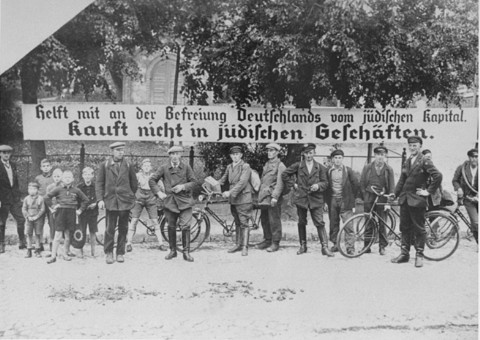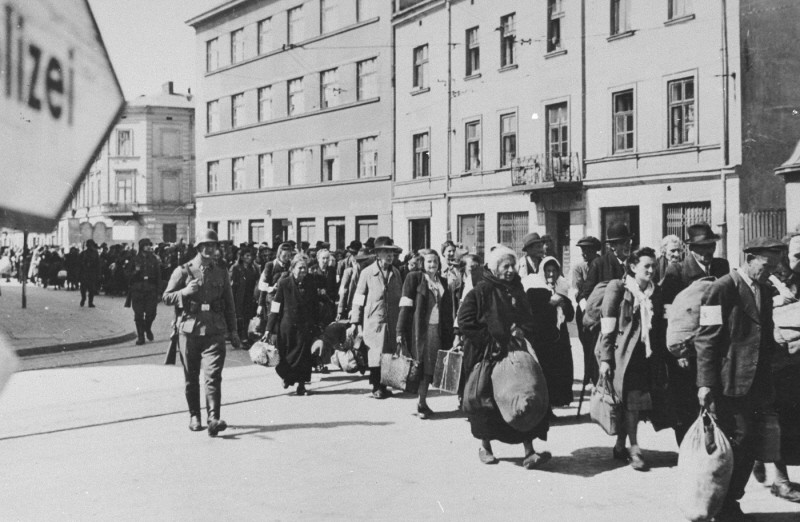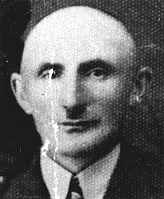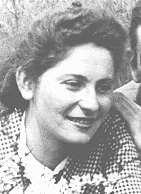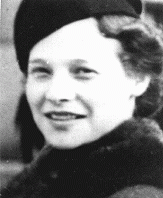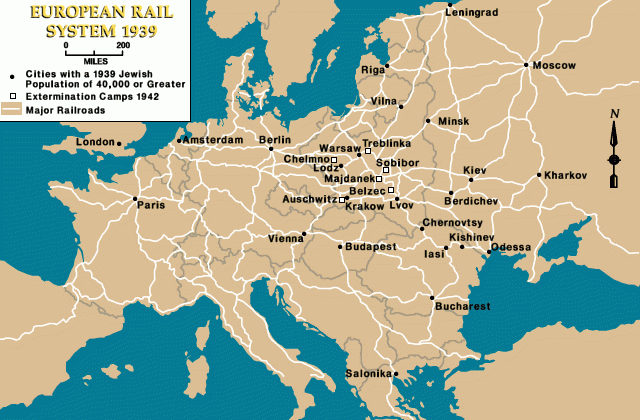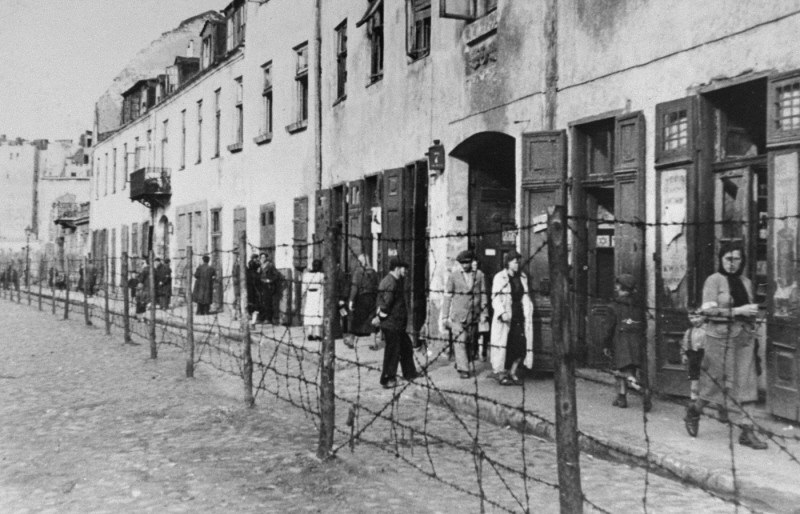
The "Final Solution"
The Nazi “Final Solution to the Jewish Question” (“Endlösung der Judenfrage”) was the deliberate, planned mass murder of European Jews. It occurred between 1941 and 1945. It was, and is, often referred to as the “Final Solution” (“Endlösung”). The “Final Solution” was the tragic culmination of the Nazi persecution of Europe’s Jews. As such, it is a key component of the Holocaust (1933–1945).
To carry out the “Final Solution,” the Germans coordinated and perpetrated the murder of Europe’s Jews. They murdered Jews by implementing policies that led to starvation; disease; random acts of terror; and mass shootings and gassings.
Did the Nazis always plan to murder the Jews?
No. When the Nazis came to power in Germany in 1933, they did not have a plan to murder the Jews of Europe. However, the Nazis were antisemitic. They saw Jews in Germany as a problem. One of the major questions for the Nazis was: How do we get rid of the Jewish population in Germany? This was often referred to by the Nazis as the “Jewish Question.”
Mass murder was not the Nazis’ first solution to the “Jewish Question.” In fact, the Nazis experimented with a variety of anti-Jewish policies and plans. For example, throughout the 1930s, they tried to force Jews to emigrate.
But World War II (1939–1945) changed how the Nazis understood the “Jewish Question.” Eventually, they decided that forced emigration of Jews was not a viable solution.
How did World War II change Nazi anti-Jewish policies?
In the first years of World War II, Nazi Germany conquered much of Europe. As a result of Nazi territorial expansion and alliances, millions of European Jews came under German control between 1939 and 1941.
During this time, the “Jewish Question” took on new proportions for the Nazis. Nazi anti-Jewish policies became more and more extreme. They affected thousands of Jewish communities. However, the Nazis did not immediately decide to commit mass murder (the “Final Solution”).
At the beginning of the war, the Nazis considered relocating entire Jewish communities. They explored plans to send Jews to a reservation in German-occupied Poland, to Siberia, or even to Madagascar, an island off the African coast. Ultimately, these plans were too hard to carry out. So, the Nazis sought other solutions to the “Jewish Question.”
In German-occupied Poland, the Germans began to create ghettos in 1939–1940. They established these ghettos to isolate Jews from the local non-Jewish population. Ghettos were separate areas of cities where German occupiers forced Jews to live in overcrowded and unsanitary conditions. These areas were often enclosed by a wall or other barriers. Many ghetto residents died as a result of disease, starvation, and brutal maltreatment.
When and how did the Nazis begin to systematically carry out mass killings of Jews?
The Nazis began to systematically commit mass killings of Jews in 1941. These systematic killings began after Germany attacked the Soviet Union in June of that year.
As the German military moved east through Soviet-controlled territory, special SS and police units followed behind. Their task was to guarantee security and to eliminate Nazi Germany’s enemies, namely Communists and Jews. In practice, these units carried out mass shootings. They soon began to murder entire Jewish communities, including men, women, and children. Sometimes, in addition to mass shootings, these units murdered Jews and others using mobile gas vans.
The systematic mass shootings and gassings reflected the radicalization of Nazi anti-Jewish policies. They marked the beginning of the “Final Solution.”
What role did the killing centers play in the “Final Solution”?
As a key part of the Nazi “Final Solution to the Jewish Question,” the Nazis created killing centers to commit mass murder. At these killing centers, the Nazis used gas chambers or mobile gas vans to murder Jews and others.
There were five killing centers: Chełmno, Bełżec, Sobibór, Treblinka, and Auschwitz-Birkenau.
The Germans deported Jews to these killing centers from all over Europe. Many deportations originated from the German-established ghettos in German-occupied Poland and elsewhere.
Is the “Final Solution” the same as the Holocaust?
No. The “Final Solution” is not the same as the Holocaust.
The Holocaust was the systematic, state-sponsored persecution and murder of Europe’s Jews from 1933 to 1945. The Holocaust was coordinated and perpetrated by Nazi Germany and its allies.
The “Final Solution to the Jewish Question” was the last stage of the Holocaust and took place from 1941 to 1945. It was the deliberate, planned mass murder of Europe’s Jews. Many Jews were killed before the “Final Solution” began. However, the vast majority of Jews who died in the Holocaust were murdered as part of the “Final Solution.”
How many Jews were killed in the Holocaust?
In total, the Nazis and their collaborators and allies murdered six million Jews in the Holocaust. This was approximately two thirds of Europe’s prewar Jewish population.
Key Dates
February 1940
The Creation of the Łódź Ghetto
In February 1940, before the start of the “Final Solution,” the German authorities establish a ghetto in Łódź, a city in German-occupied Poland. At the time, Łódź is home to the second largest Jewish community in Europe. In 1940, the Germans force more than 160,000 Polish Jews into the Łódź ghetto. It is surrounded by a barbed wire and wooden fence. Forced labor, overcrowding, and hunger are the dominant features of life in the Łódź ghetto.
The creation of the Łódź ghetto is an example of German efforts to isolate Jews from the non-Jewish population.
October–November 1941
Deportations of Jews from Western and Central Europe to the Łódź Ghetto
In October and November 1941, German officials deport approximately 20,000 Jews from western and central Europe to the Łódź ghetto. This includes Jews from cities such as Berlin, Vienna, and Prague. Many of these Jews are elderly and sick. More than 3,000 of them die in the first seven months. The arrival of these deportations further disrupts life in the Łódź ghetto, exacerbating overcrowding.
These deportations are part of a major escalation of Nazi anti-Jewish policy in fall 1941. At this time, Nazi leaders decide to try to make German cities “cleansed of Jews” (“judenrein”). The deportations to the Łódź ghetto are the first step in this process.
January 16, 1942
Deportations of Jews from the Łódź Ghetto to the Chełmno Killing Center Begin
On January 16, 1942, as part of the “Final Solution,” German authorities begin deporting Jews from the Łódź ghetto to the Chełmno killing center. The Germans establish the killing center in Chełmno specifically to murder Jews from the Łódź ghetto and the surrounding areas. The killing center is located only about 30 miles from the city of Łódź. Gassing operations had begun at the killing center in December 1941. At Chełmno, the Jewish deportees are killed in mobile gas vans.
By the summer of 1944, German authorities murder approximately 77,000 Jews from the Łódź ghetto in Chełmno. In total at least 167,000 Jews are murdered at Chełmno. The vast majority of them were Jews from the surrounding region, including Łódź.


